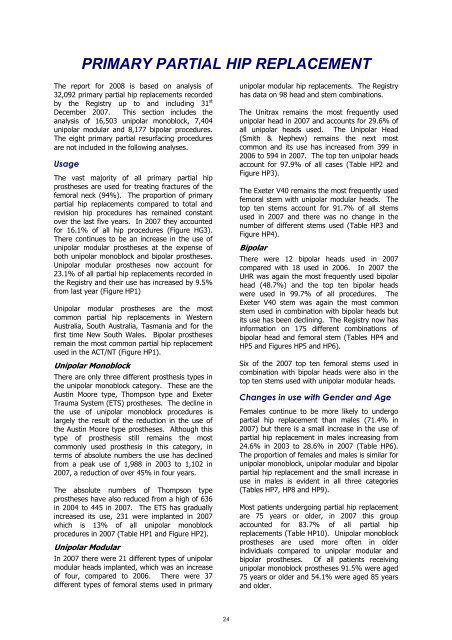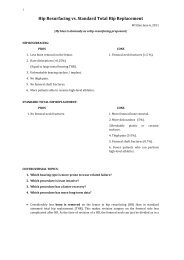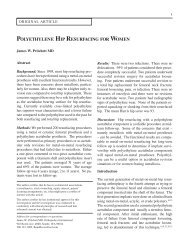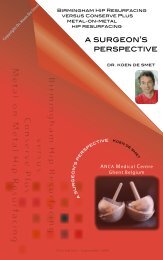Hip and Knee Arthroplasty - Surface Hippy Guide to Hip Resurfacing
Hip and Knee Arthroplasty - Surface Hippy Guide to Hip Resurfacing
Hip and Knee Arthroplasty - Surface Hippy Guide to Hip Resurfacing
You also want an ePaper? Increase the reach of your titles
YUMPU automatically turns print PDFs into web optimized ePapers that Google loves.
PRIMARY PARTIAL HIP REPLACEMENT<br />
The report for 2008 is based on analysis of<br />
32,092 primary partial hip replacements recorded<br />
by the Registry up <strong>to</strong> <strong>and</strong> including 31 st<br />
December 2007. This section includes the<br />
analysis of 16,503 unipolar monoblock, 7,404<br />
unipolar modular <strong>and</strong> 8,177 bipolar procedures.<br />
The eight primary partial resurfacing procedures<br />
are not included in the following analyses.<br />
Usage<br />
The vast majority of all primary partial hip<br />
prostheses are used for treating fractures of the<br />
femoral neck (94%). The proportion of primary<br />
partial hip replacements compared <strong>to</strong> <strong>to</strong>tal <strong>and</strong><br />
revision hip procedures has remained constant<br />
over the last five years. In 2007 they accounted<br />
for 16.1% of all hip procedures (Figure HG3).<br />
There continues <strong>to</strong> be an increase in the use of<br />
unipolar modular prostheses at the expense of<br />
both unipolar monoblock <strong>and</strong> bipolar prostheses.<br />
Unipolar modular prostheses now account for<br />
23.1% of all partial hip replacements recorded in<br />
the Registry <strong>and</strong> their use has increased by 9.5%<br />
from last year (Figure HP1)<br />
Unipolar modular prostheses are the most<br />
common partial hip replacements in Western<br />
Australia, South Australia, Tasmania <strong>and</strong> for the<br />
first time New South Wales. Bipolar prostheses<br />
remain the most common partial hip replacement<br />
used in the ACT/NT (Figure HP1).<br />
Unipolar Monoblock<br />
There are only three different prosthesis types in<br />
the unipolar monoblock category. These are the<br />
Austin Moore type, Thompson type <strong>and</strong> Exeter<br />
Trauma System (ETS) prostheses. The decline in<br />
the use of unipolar monoblock procedures is<br />
largely the result of the reduction in the use of<br />
the Austin Moore type prostheses. Although this<br />
type of prosthesis still remains the most<br />
commonly used prosthesis in this category, in<br />
terms of absolute numbers the use has declined<br />
from a peak use of 1,988 in 2003 <strong>to</strong> 1,102 in<br />
2007, a reduction of over 45% in four years.<br />
The absolute numbers of Thompson type<br />
prostheses have also reduced from a high of 636<br />
in 2004 <strong>to</strong> 445 in 2007. The ETS has gradually<br />
increased its use, 231 were implanted in 2007<br />
which is 13% of all unipolar monoblock<br />
procedures in 2007 (Table HP1 <strong>and</strong> Figure HP2).<br />
Unipolar Modular<br />
In 2007 there were 21 different types of unipolar<br />
modular heads implanted, which was an increase<br />
of four, compared <strong>to</strong> 2006. There were 37<br />
different types of femoral stems used in primary<br />
unipolar modular hip replacements. The Registry<br />
has data on 98 head <strong>and</strong> stem combinations.<br />
The Unitrax remains the most frequently used<br />
unipolar head in 2007 <strong>and</strong> accounts for 29.6% of<br />
all unipolar heads used. The Unipolar Head<br />
(Smith & Nephew) remains the next most<br />
common <strong>and</strong> its use has increased from 399 in<br />
2006 <strong>to</strong> 594 in 2007. The <strong>to</strong>p ten unipolar heads<br />
account for 97.9% of all cases (Table HP2 <strong>and</strong><br />
Figure HP3).<br />
The Exeter V40 remains the most frequently used<br />
femoral stem with unipolar modular heads. The<br />
<strong>to</strong>p ten stems account for 91.7% of all stems<br />
used in 2007 <strong>and</strong> there was no change in the<br />
number of different stems used (Table HP3 <strong>and</strong><br />
Figure HP4).<br />
Bipolar<br />
There were 12 bipolar heads used in 2007<br />
compared with 18 used in 2006. In 2007 the<br />
UHR was again the most frequently used bipolar<br />
head (48.7%) <strong>and</strong> the <strong>to</strong>p ten bipolar heads<br />
were used in 99.7% of all procedures. The<br />
Exeter V40 stem was again the most common<br />
stem used in combination with bipolar heads but<br />
its use has been declining. The Registry now has<br />
information on 175 different combinations of<br />
bipolar head <strong>and</strong> femoral stem (Tables HP4 <strong>and</strong><br />
HP5 <strong>and</strong> Figures HP5 <strong>and</strong> HP6).<br />
Six of the 2007 <strong>to</strong>p ten femoral stems used in<br />
combination with bipolar heads were also in the<br />
<strong>to</strong>p ten stems used with unipolar modular heads.<br />
Changes in use with Gender <strong>and</strong> Age<br />
Females continue <strong>to</strong> be more likely <strong>to</strong> undergo<br />
partial hip replacement than males (71.4% in<br />
2007) but there is a small increase in the use of<br />
partial hip replacement in males increasing from<br />
24.6% in 2003 <strong>to</strong> 28.6% in 2007 (Table HP6).<br />
The proportion of females <strong>and</strong> males is similar for<br />
unipolar monoblock, unipolar modular <strong>and</strong> bipolar<br />
partial hip replacement <strong>and</strong> the small increase in<br />
use in males is evident in all three categories<br />
(Tables HP7, HP8 <strong>and</strong> HP9).<br />
Most patients undergoing partial hip replacement<br />
are 75 years or older, in 2007 this group<br />
accounted for 83.7% of all partial hip<br />
replacements (Table HP10). Unipolar monoblock<br />
prostheses are used more often in older<br />
individuals compared <strong>to</strong> unipolar modular <strong>and</strong><br />
bipolar prostheses. Of all patients receiving<br />
unipolar monoblock prostheses 91.5% were aged<br />
75 years or older <strong>and</strong> 54.1% were aged 85 years<br />
<strong>and</strong> older.<br />
24






